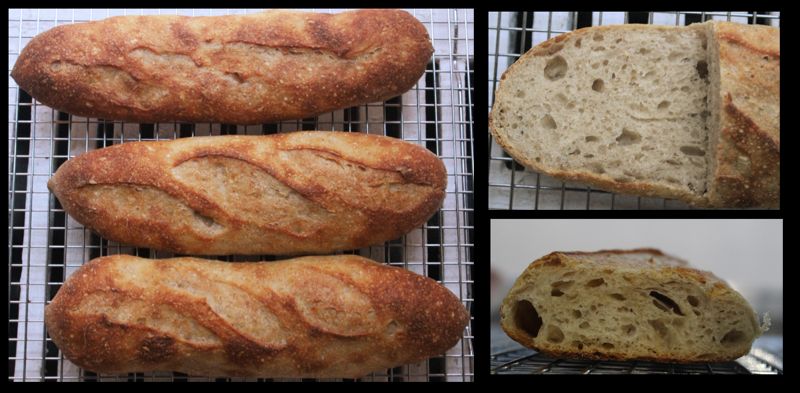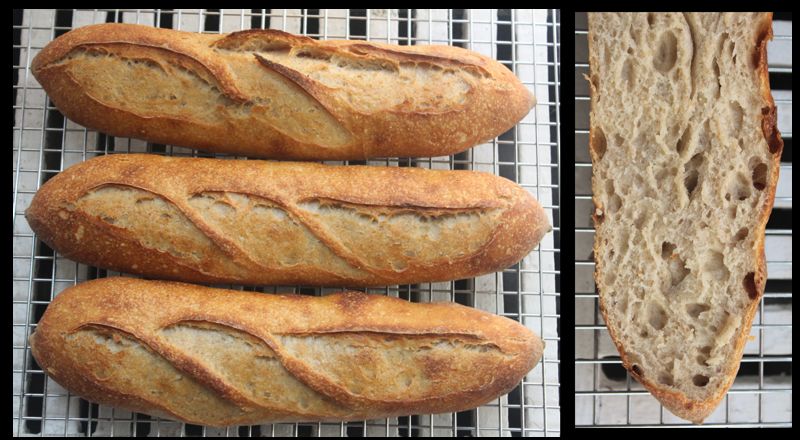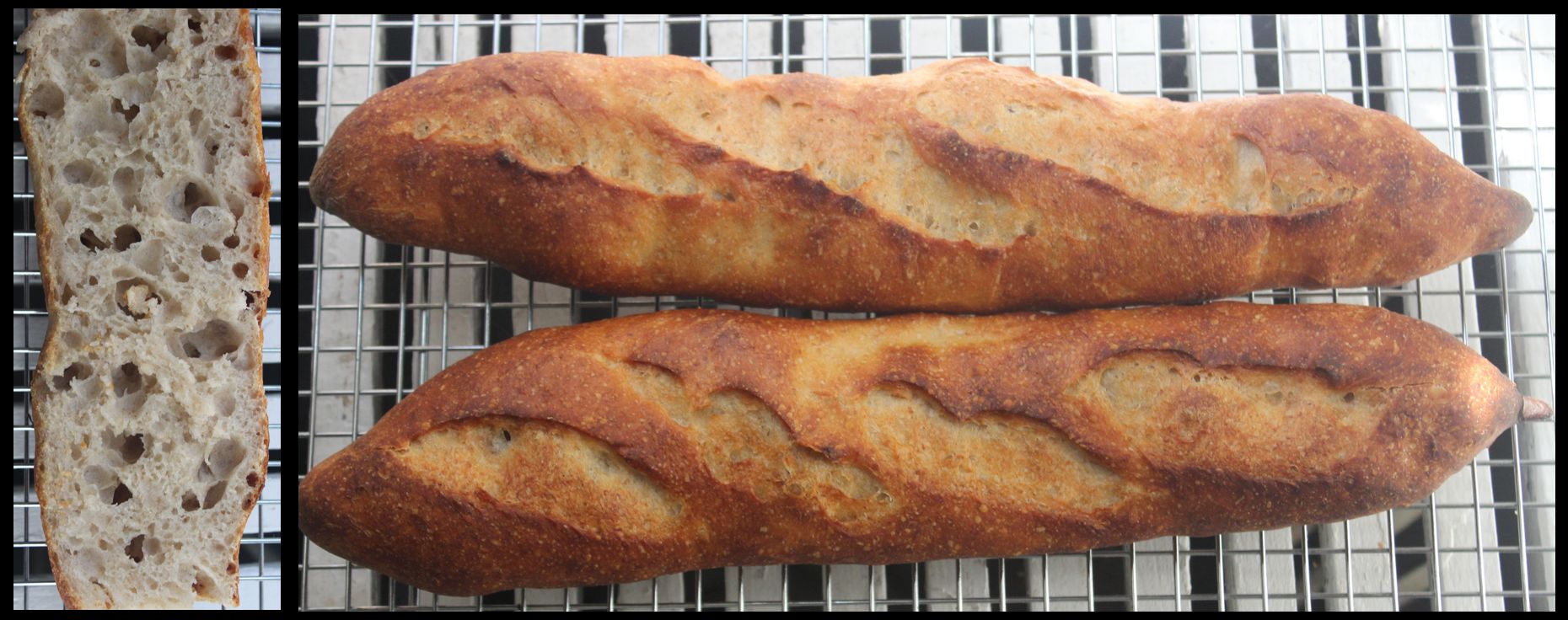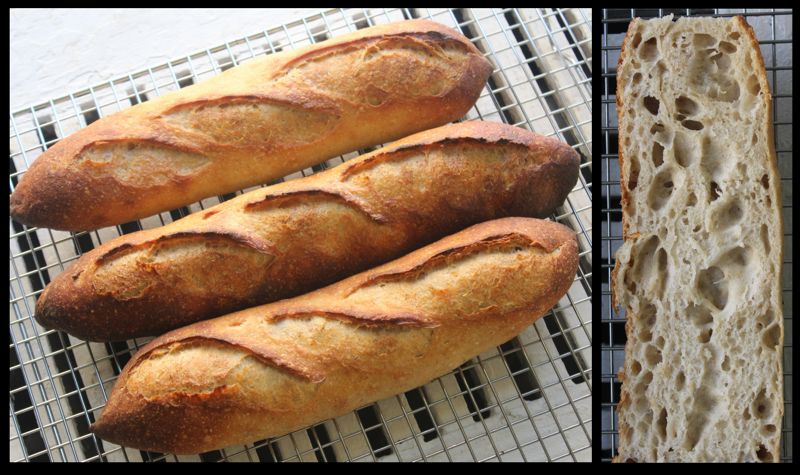One more step....
Process
http://www.thefreshloaf.com/node/51572/vermont-sd-baguettes-course
Scaled to around 240g each.
First four below were made with the baking set up described in Baguettes II
Baking process
Last one was made with a newly acquired baking stone, covered by a disposable foil roasting pan. The foil pan comes off half way through baking. An unheated cast iron pan was stacked on top of the foil roasting pan during baking to make sure that the edges of the roasting pan were flush with the stone to maximize trapped steam (could also fit an ice cube under, but haven't tried it yet).
I was unsure whether the baking stone would be better than the cast iron pans with a heated baking sheet on top that I was using. While I've only used the stone for one bake so far, my impression is that the stone is better: unlike the pans, the stone does not scorch the bottoms of the loaves and oven spring seemed more even. More bakes will be needed to validate these impressions.
Results
I. Random grocery store flour. I did not create enough surface tension when shaping these, and humidity on the bake day meant that they got a bit moist after being rested under plastic while the oven was heating. Together with overly horizontal scoring, this resulted in messy loaves with a flat cross-section.

II. Random grocery store flour. Switched from resting on a sheet covered with plastic to resting on a large, smooth cotton cloth. Even without flour, they did not stick to the cloth, and it dried the surface of the loaves, making them noticably easier to score.

III. First batch with newly available KA AP flour. Crumb much lacier and more open than on previous attempts. Dough was oddly sticky, making shaping and scoring difficult (hence the lumps).

IV. Another KA batch. My scoring angle was bad, but the crumb was similar to III and the loaves were not lumpy. Unclear why dough was sticky in III. Maybe a measuring error? Maybe some other small thing that I didn't notice?
V. Random grocery store flour; first stone bake. Did about 100 french folds to develop. Scoring was easier and worked better on these. Shaping went realtively smoothly, although (as in many of these bakes) it's clear that I need to work on making the girth of the loaves more even. Best ears that I've gotten so far, but crumb seemed a little bit underproofed. This is probably because I put the dough on a different (slightly colder) shelf of my fridge than usual. Should have given them a longer final proof to compensate for this.

General lessons
In Baguettes II, kendalm and MTloaf pointed out that some of my problems were essentially arising from handling the dough too gently. This has been a very good tip for both baguettes and for bread in general: I was always afraid to hurt the dough, but it's more resilient than I thought.
Relatedly, baguettes have also improved my understanding of the role of tension in bread. Lack of tension in baguettes is much more obvious than in boules.
Questions
Obviously, there's still a long way to go. I have a nebulous swarm of questions, but I think that doing more bakes will help winnow and refine them, so I'll keep them in my brain for now.
Thanks to everyone who has generously given me advice so far.
- algebread's Blog
- Log in or register to post comments
You’re doing great and much braver than I am with doing a sourdough baguette. I figured I would start with IDY recipe and wet my chops and learn how to shape and score etc before I try the challenge of a SD baguette. Yours look excellent.
Benny
Thank you for your kind comments. When I started this "project", the sourdough was born of necessity rather than courage, as there was no IDY to be found at any grocery store.
I look forward to improving with you.
You are making great progress. The stone and cover are an obvious improvement. I agree that the mass helps to regulate the oven temperature. I see your shaping and scoring is getting better all the time. KA AP is somewhat sticky but if you pat it down first with a well floured hand it is nice to work with. Building tension in a sourdough baggie is a little more difficult than an IDY version. Almost a different shaping technique. I found the method used in this video to be interesting way to create tension. Sourdough baguettes
Looking forward to the your next chapter
Thank you for your advice. I will definitely be giving the KA another shot.
The dough in the video has remarkable extensibility. When I am shaping, it is usually cold and hence a little on the stiff side---I will have to try not retarding (or just letting the dough warm up all the way) sometime to see how shaping is that way.
Jus about everything is on track, and you can see for yourself how a "low" hydration dough can yield an open crumb with the right feel for the dough at the divide/pre-shape and shape steps. Improvements in shape, scoring and crumb are all on display here.
As far as flour type - there are certainly some supermarket branded flours that are weaker than others and don't do the job all that well. But I also think that to a fair extent the result is more associated with the skillset of the baker at all phases. I tend to favor KA AP flour only because I can buy it at about the same price as Gold Medal and Pillsbury, but my higher protein Bread Flour is almost always one of those two.
Baking stones. Initially I used what is commonly referred to as unglazed Saltillo garden tiles/pavers. And when these began to crack mercilessly over time, I replaced it with a cut to size (US $20) granite slab. In all the bakes these past half dozen years on these two baking decks I cannot recall ever scorching the bottoms. And as MT said, the heat from the mass and heat retention of a true baking deck can't be overstated.
Nice to see such fine progress!
alan
The skillset explanation is what I would expect---a skilled baker can produce a wide range of crumbs from a wide range of materials. I also want to experiment more with dough development to see how far I can push my "random grocery store" results, if for no other reason than the random grocery store flour being super cheap relative to national brands.
You mentioned your granite slab before, so I contacted a few countertop places around here to see what they had, but unfortunately, the scraps that they had were all far too large for my oven and they would have charged me for cutting them down to size, so it was ultimately cheaper for me to just order a stone.
Thank you for your advice, encouragement, and baguette inspiration.
Hey looks like your getting better. A lot of details in your post which is great. The one thing that now sticks out the most here seems to be that your loaves I and III are over proofed. Interestingly you state that number IV is under proofed. I would say that this bake and number II are actually more like properly proofed - nice life in the scores and good crumb - do that more often. !
I made this remark due to the thickness of the walls of the air cells---bake V had thicker cells walls than III. In other loaf shapes, I usually aim for thinner walls and find that bulking longer and to larger volume tends to lead to thinner cell walls. At the same time, V and III use quite different strengths of flour, so my assessment here is probably invalid. Thanks for all of your advice!